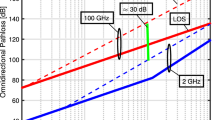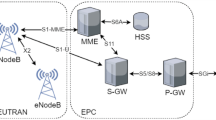Abstract
This paper analyzes and evaluates the statistical properties of the rms delay spread (delay spread) in a two-path simulcast environment and same frequency in cell repeater. Each path is subjected to multipath fading characterized by wideband Weibull distribution. A novel, unified, and accurate analytical expressions for the probability density function, the cumulative distribution function, the mean, the mean square, and the standard deviation for the delay spread have been derived. The derived expressions are then used to study the implication of the fading and scale parameters on the statistical characteristics of the delay spread. To validate the accuracy of the derived formulas, the analytical results are compared with Monte-Carlo simulation results. Full agreement has been noticed between the simulated and the analytical results over a wide range of received signals levels ratio and different values of the fading parameters.










Similar content being viewed by others
References
Gray, G. D. (1979). The simulcasting technique: An approach to total-area radio coverage. IEEE Transaction on Vehicular Technology, 28, 117–125.
Desourdis, R. (2001). Emerging public safety wireless communication systems (1st ed.). Norwood: Artech.
Dunlop, J., Girma, D., & Irvine, J. (2013). Digital mobile communications and the TETRA system. New York: Wiley.
Reed, J . H., Rappaport, T . S., & Woerner, B . D. (2012). Wireless personal communications: Advances in coverage and capacity (Vol. 377). Berlin: Springer.
Heath, R., Peters, S., Wang, Y., & Zhang, J. (2013). A current perspective on distributed antenna systems for the downlink of cellular systems. IEEE Communications Magazine, 51(4), 161–167.
Soriaga, J., Au, J., Tang, K., Warner, J., Piekarski, B., Lott, C., & Attar, R. (2013). Improving the capacity of an existing cellular network using distributed antenna systems and right-of-way cell sites. In 2013 IEEE 78th vehicular technology conference (VTC Fall) (pp. 1–7). IEEE.
Carlà, L., Fantacci, R., Gei, F., Marabissi, D., & Micciullo, L. (2015). Lte enhancements for public safety and security communications to support group multimedia communications. arXiv preprint arXiv:1501.03613.
Roh, W. (2003). High performance distributed antenna cellular networks. Ph.D. dissertation, Stanford University.
Molisch, A. F. (1996). Statistical properties of the rms delay-spread of mobile radio channels with independent Rayleigh-fading paths. IEEE Transaction on Vehicular Technology, 45(1), 201–205.
Doumi, T. L., Tsioumparakis, K. H., & Gardiner, J. G. (1995). Delay spread statistics in vicinity of same-frequency repeater. Electronic Letters, 31(18), 1607–1609.
Doumi, T. L., Tsioumparakis, K. H., & Gardiner, J. G. (1996). Delay spread statistics in a two-path radio environment. In The 46th IEEE vehicular technology conference-VTC, 1996 (pp. 642–646).
Wang, X.-D., Rui, G.-S., Xu, H.-Y., & Bu, Z.-Y. (2007). Delay spread statistics in a two-path distributed antenna system with gamma-lognormal fading channels. IEEE Communications Letters, 11(8), 656–658.
Tsioumparakis, K. H., Doumi, T. L., & Gardiner, J. G. (1997). Delay-spread considerations of same-frequency repeaters in wideband channels. IEEE Transactions on Vehicular Technology, 46(3), 664–675.
Alshamali, A., & Al-Oqleh, M. (2002). Delay spread statistics in simulcast transmission system. Electronics Letters, 38(17), 992–994.
Alshamali, A. M., & Al-Oqleh, M. (2005). Statistical properties of the delay spread in a two path mobile radio with Nakagami fading channel. AEU-International Journal of Electronics and Communications, 59(4), 222–229.
Weibull, W. (1951). Wide applicability. Journal of Applied Mechanics, 103, 293–297.
Sagias, N. C., Zogas, D. A., Karagiannidis, G. K., Tombras, G. S., et al. (2004). Channel capacity and second-order statistics in Weibull fading. IEEE Communications Letters, 8(6), 377–379.
Simon, M. K., & Alouini, M. (2005). Digital communication over fading channels (2nd ed.). New York: Wiley.
Aloqlah, M. S., Alshamali, A., Salman, & T. Bani. (2016). Development of accurate expressions for the estimation of delay spread in simulcast networks under weibull fading. In 2016 international conference on computing, networking and communications (ICNC). IEEE.
Salman, T. B. (2015). Statistical properties of the delay spread in a two-path mobile radio with Weibull fading channel. Master’s thesis, Yarmouk University
Molisch, A. F. (2007). Wireless communications. New York: Wiley.
Mathai, A., & Saxena, R. (1978). The H-function with applications in statistics and other disciplines. New Delhi: Wiley Eastern.
Yilmaz, F., & Alouini, M.-S. (2009). Product of the powers of generalized Nakagami-m variates and performance of cascaded fading channels. In Proceedings of the global telecommunications conference, GLOBECOM 2009
Papoulis, A., & Pillai, S . U. (1991). Probability, random variables, and stochastic processes. New York: Tata McGraw-Hill Education.
Kilbas, A. A. (2004). H-transforms: Theory and applications. Boca Raton: CRC Press.
Gradshteyn, I. S., & Ryzhik, I. M. (2007). Table of integrals, series, and products (7th ed.). Cambridge: Academic Press.
Author information
Authors and Affiliations
Corresponding author
Additional information
Publisher's Note
Springer Nature remains neutral with regard to jurisdictional claims in published maps and institutional affiliations.
Appendices
Appendix 1: Proof of Theorem 1
To obtain a formula for the PDF of the ratio R and under the assumption that the random variables X and Y are statistical independents, the following integral [24, (6.43)]
has to be expressed in closed form. After substituting (5) and (6) into (19), we get
Invoking identity [25, 2.9.4], namely, \({e^{ - z}} = H_{0,1}^{1,0}\left[ {z\left| {\begin{array}{c} - \\ {\left( {0,1} \right) } \end{array}} \right. } \right]\), then applying [25, Theorem 2.9], \({f_R}\left( r \right)\) can be expressed in closed form as in (7). Hence, the proof is completed.
Appendix 2: Proof of Lemma 1
The mean rms delay spread can be expressed as
In order to derive a closed form expression for the above integral, two approximations will be carried out on both the numerator and denominator of \(\tau _{rms}(R)\). Hence, the numerator of \(\tau _{rms}(R)\) can be expressed as [13]
Note that, an appropriate numerical algorithm has been reported in [13] which is utilized in this study in order to estimate the values of the parameters \(k_i\), \(i=1, 2\), and 3 and the values of \(R_i\), \(i=1\) and 2. The denominator can also be expanded with the appropriate Taylor series as [26]
After utilizing the above approximations and splitting the integrals into appropriate partitions, \(\left\langle {{\tau _{rms}}} \right\rangle\) can be expressed as
Placing (7) in (25), the following integrals with respect to r, namely, \(\mathcal {I}_1\), \(\mathcal {I}_2\), \(\mathcal {I}_3\), and \(\mathcal {I}_4\) appear. Utilizing [25], these integrals can be expressed in closed forms as
where \(\phi _1=\Big \{ \left( { - \frac{k_y}{k_x},\frac{k_y}{k_x}} \right) ,\left( {1 - {k_y} + m,{k_y}} \right) \Big \}\) and \(\phi _2=\Big \{ \left( { - {k_y} + m,{k_y}} \right) ,\left( {0,1} \right) \Big \}\).
where \(\phi _3=\Big \{ \left( {1 - {k_y} + m,{k_y}} \right) ,\left( { - \frac{{{k_y}}}{{{k_x}}},\frac{{{k_y}}}{{{k_x}}}} \right) \Big \}\) and \(\phi _4=\Big \{ \left( {0,1} \right) ,\left( { - {k_y} + m,{k_y}} \right) \Big \}\). Finally, the mean value of the rms delay spread can be written as in (8). Hence, the proof is completed.
Appendix 3: Proof of Lemma 2
Utilizing the basic definition of the generalized moments in conjunction with the unified PDF in (7), that is
The rational expression in the above equation, namely, \({\left( {{r^2} + 1} \right) ^{ - 2}}\) can be expanded with the appropriate Taylor series as [26]
We rearrange (31) as
Finally, one can easily obtain an expression for the (32) as in (9). Thus, the proof is completed.
Rights and permissions
About this article
Cite this article
Aloqlah, M.S., Alshamali, A.M. & Salman, T.B. Study of Delay Spread for Simulcast Radio Transmission in Time-Dispersive Mobile Radio Networks. Wireless Pers Commun 101, 1157–1176 (2018). https://doi.org/10.1007/s11277-018-5754-x
Published:
Issue Date:
DOI: https://doi.org/10.1007/s11277-018-5754-x




